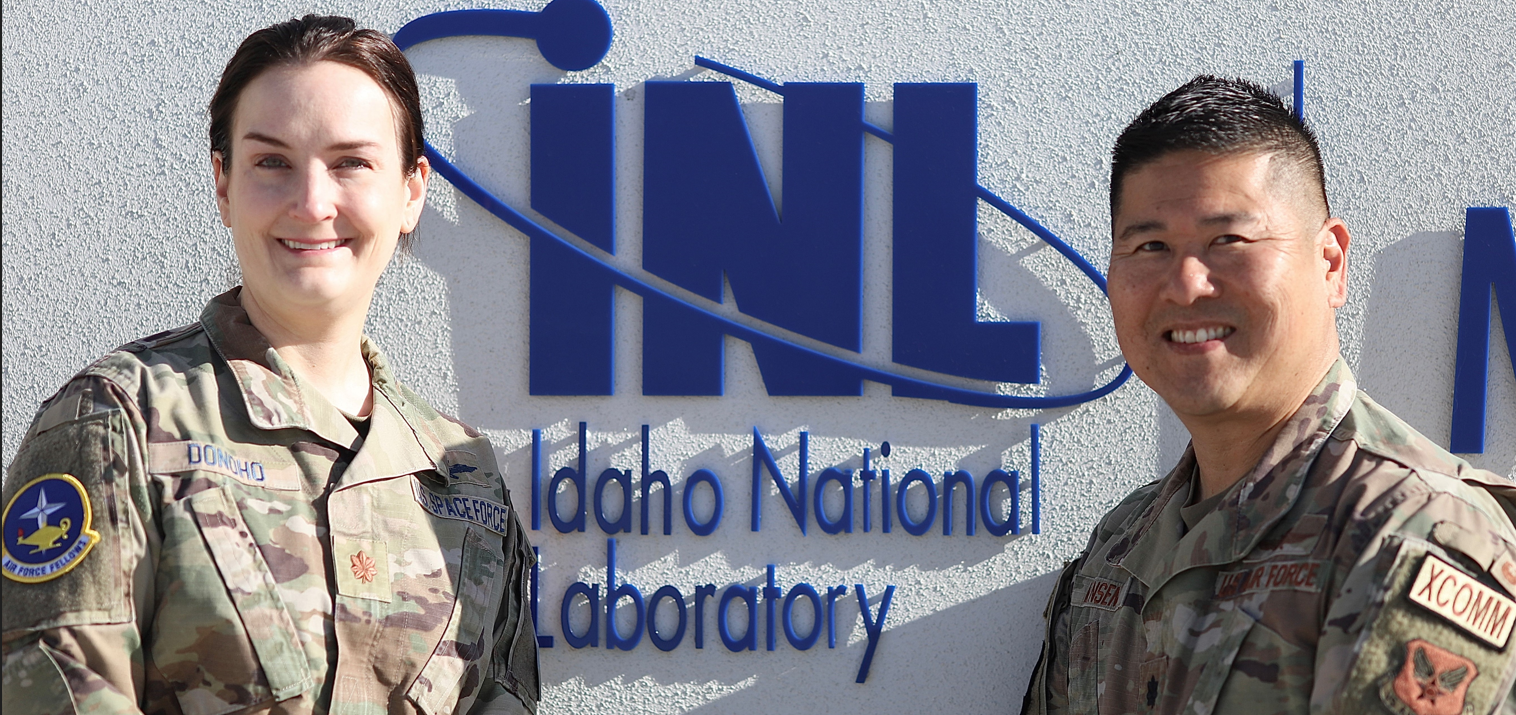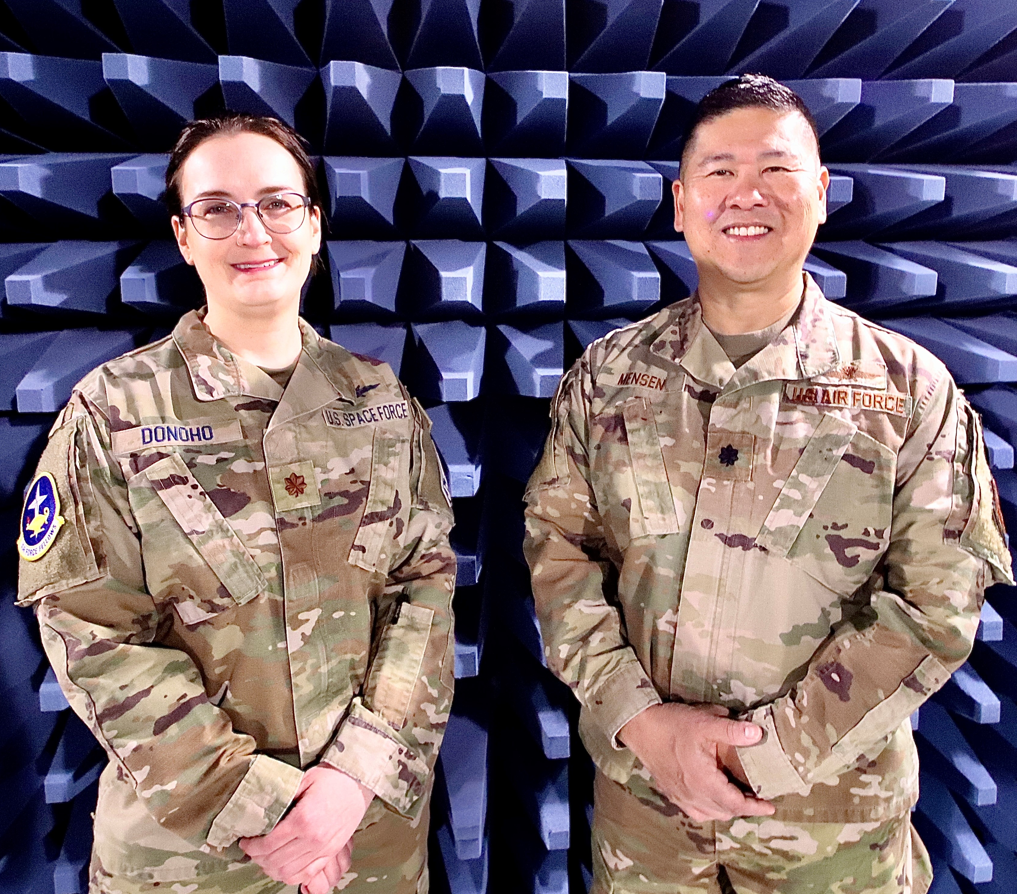Since 2010, Idaho National Laboratory (INL) has partnered with the U.S Air Force Fellows Program to advance national security proficiencies in our military leaders. The latest participants, Lt. Col. Kurando “Claude” Mensen and Maj. Rachel E. Donoho, said they have gained new skills and information they never anticipated when their tours started in August 2023.
“I’d heard about this program and was told it was one of the Air Force’s best kept secrets, and it is,” said Mensen, who is returning to Eglin Air Force Base in Florida, where he serves as deputy commander of the 96th Mission Support Group.
“This has been very eye-opening,” said Donoho, who serves in the U.S. Space Force and will be returning to Alabama. Both have spent 10 months at INL learning about cybersecurity and Consequence-driven Cyber-informed Engineering (CCE), a methodology developed at INL to address threats to the nation’s critical infrastructure systems.
CCE leverages the assumption that if a system is targeted by a skilled and determined adversary, the targeted network can and will be penetrated. Using a “think like the adversary” approach allows cybersecurity to be engineered into a system and threats to be engineered out throughout its development. By identifying and prioritizing operations that must not fail, CCE enables critical function assurance. It’s an area of growing interest to the Department of Defense. “This is the first place I’ve been where they’ve thought systematically about continuing to function in adverse conditions,” Donoho said.

The mission
The mission of the Air Force Fellows Program is to provide “competitively selected, highly qualified field-grade Air and Space Force officers and their civilian counterparts an in-depth education in national security policy through assignments to a distinguished civilian institute or placement in a key government agency or department.”
Each year, about 150 officers are selected and posted to national laboratories, universities, federal agencies and think tanks. Fellows are selected through a rigorous review based on merit, rank in their respective career fields and education and experience relevant to their missions. The goal is to provide the Air Force with current scholarly perspectives on strategy and defense policy, and to analyze future technologies that are critical for U.S. warfare capabilities and increased interoperability with allies and partners.
The selected Air Force fellows are officers who’ve been acknowledged as up-and-comers, said Bob Timpany, INL National and Homeland Security Infrastructure Relationship manager and former INL U.S. Air Force fellows’ mentor.
The program has changed in some ways since it started, he said. It used to be that fellows would come and observe and write a paper at the end of their time. But in the past five years, the program has become more focused on program, he said. The U.S. Air Force admitting personnel from the Space Force is a new “wrinkle for INL,” that leverages the current fellows program.
INL gains as much from participating in the program as the people sent by the Air Force. “Their background and expertise is invaluable,” Timpany said.
Broader perspectives
Although the Air Force fellows who come to INL are focused on cybersecurity, Mensen said he was grateful for the opportunity to learn about the lab’s various missions and was amazed at how much it has to offer.
Mensen has served in a wide variety of positions at the platoon, squadron, division, joint and headquarters levels. He has assumed duties in various roles and deployments including a tour leading an Army postal platoon, followed by serving as communications planner for the Joint Air Component Coordination Element of U.S. Forces in Iraq and then as division chief in the Combined Air Operations Center Air Force Forces A2 Directorate.

Donoho has also served in several capacities, including with the 660th Network Operations Squadron, where she was responsible for a 398-member joint and contractor force. This team operated and defended the National Reconnaissance Office’s global communications network, which supports 70,000 users across 808 sites. While the internet and digital technology have revolutionized communication, she remains concerned about their vulnerabilities. “I don’t trust technology that much,” she said.
At INL, she has had the opportunity to learn more about radio frequency communications, an older technology that still has some advantages over Internet Protocol, which eliminates distance as a variable.
“It’s important to learn how to do your job without a computer and how to work in an environment where something has gone wrong,” she said.
IT and OT merging
As runners in “Red Team vs. Blue Team” exercises conducted as part of INL’s Industrial Control Systems Cybersecurity course, they received hands-on training that helped them understand how to protect and secure control systems against cyberattacks.
INL has been a leader in studying the barriers between information technology and operational technology. Information technology systems store, retrieve and send information while operational technology includes programmable systems or devices that interact with the physical environment.
“The distinction between IT and OT is becoming blurry,” Donoho said. “It’s a big concern, and I think DOD is moving at about the same speed as industry in terms of awareness. Everyone is starting to catch on.”
INL has a good reputation as a place for applied science, and Donoho said she found that to be true. “You hear a lot about the brain-bending stuff that’s being done at other national laboratories, but INL is doing stuff that can be rolled out at scale,” she said.
Reflecting on the past year, Mensen expressed gratitude and fulfillment for his personal and professional journey during his Air Force fellowship. If given the chance, he would welcome a return because of the supportive environment and ample opportunities available. “There seems to be a place here to leverage a variety of skills,” he said, highlighting INL’s unique combination of expertise, research capabilities and collaborative partnerships.





